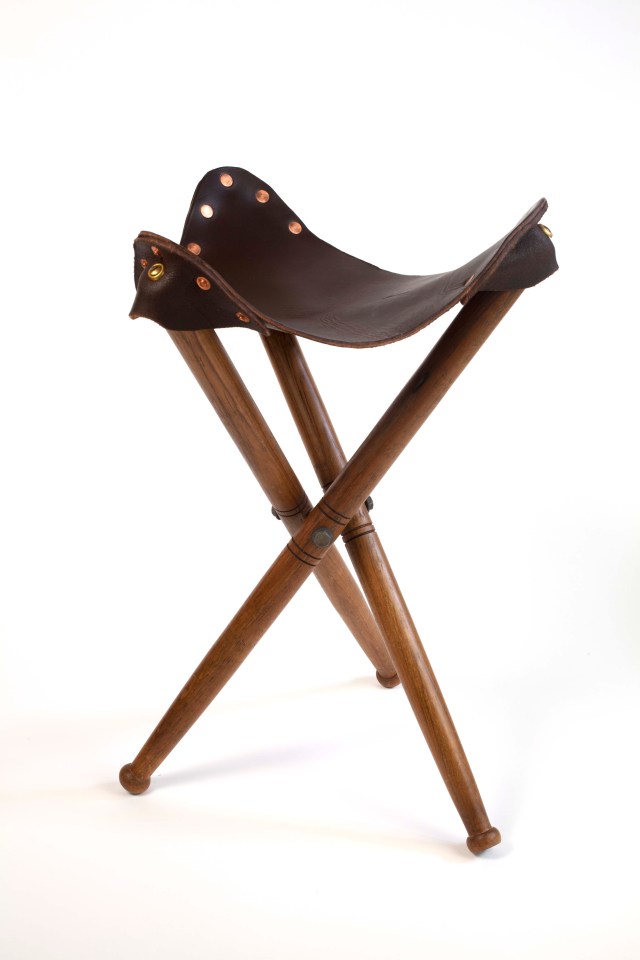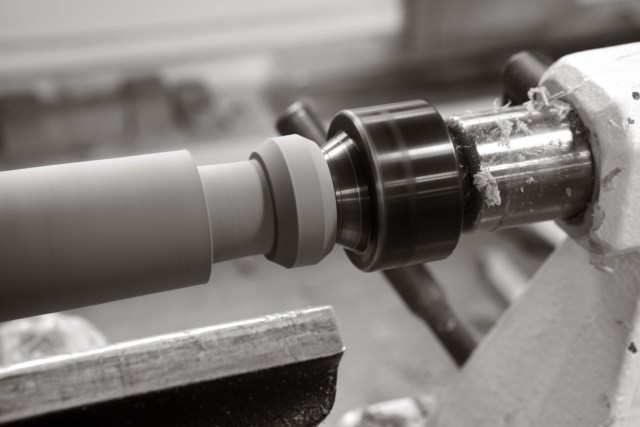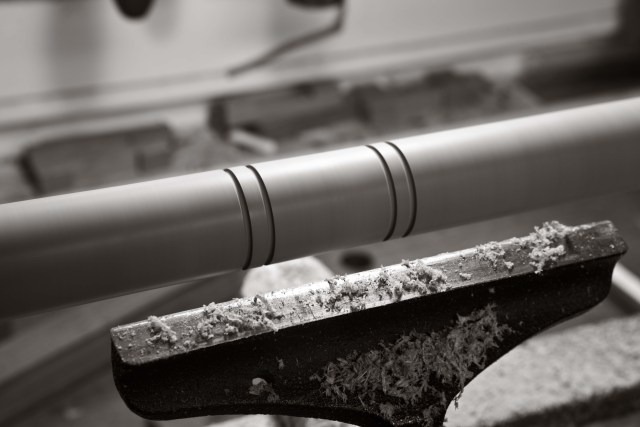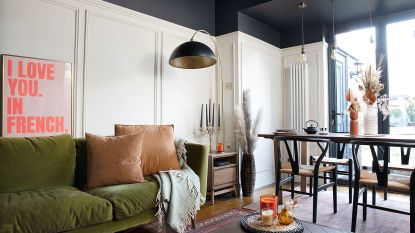
A camp stool in teak with latigo bridle leather and copper rivets.
The following in excerpted from Christopher Schwarz’s “Campaign Furniture.” After the book was published (2014), a number of people suggested alternatives to the tri-bolt shown below, including a version from Mike Siemsen, an inexpensive store-bought one from Tandy Leather (available in three finishes), and a fancy-lad (or fancy-lass) store-bought solution from Lee Valley Tools.
I have one of these stools, and use it every year at my neighborhood’s storied Fourth of July Parade and other community events. And it’s seen almost weekly use at outdoor gatherings during the last 18 months or so – the addition of a carrying strap made it particularly comfortable and convenient to sling over my shoulder as I walked to various neighbor’s houses for socially distanced gatherings; the strap left my hands free for carrying bourbon.)
— Fitz
Three-legged folding stools appear in many Western cultures, including the French, English and American. They have been popular with soldiers, sportsmen, campers and artists for at least two centuries.
This stool is a great introductory project to campaign furniture, especially if you are new to turning or working with leather. There are only three pieces of wood, four pieces of leather and some metal hardware. You can easily build one in a day.
Choosing Materials
I have seen some of these camp stools built using dowels, and they are strong enough to hold most people. However, I like to build them from mahogany, teak or ash that has dead-straight grain. I’ve had nightmares about getting a stick stuck in my backside from a stool disaster.
If you can build the stool with riven stock (oak or ash are good choices), it will be quite strong. Many original stools used 1″-diameter legs. However, my recommendation is to use stouter stock. I have built reproductions with 1″-diameter legs, and they felt too springy under my 185-pound frame.
You don’t need to make the legs baseball bats, but try for something between 1-1/8″ diameter to 1-1/4″ diameter. The leather can be almost anything 7 ounces (just shy of 1/8″ thick) or heavier. Vegetable-tanned leather that you dye yourself is a particularly strong choice.
You also will need rivets to join the leather pieces – unless you are skilled at hand-stitching. While hollow rivets (sometimes called rapid rivets) are inexpensive, easy to find and strong enough, I prefer the look and unerring permanence of solid copper rivets. I used No. 9 rivets with posts that are 1/2″ long.
To attach the leather to the wooden legs, you’ll need three No. 10 x 1-1/2″-long brass screws plus matching finishing washers.
Finally, you’ll need the hardware that allows the legs to open and shut. Traditionally, this was a three-headed bolt that once was easy to find. Now, that hardware is rare in North America. If you are a blacksmith or have access to a good welder, making a three-way bolt is straightforward. I have seen a couple of these bolts for sale in England, but the price with shipping to the United States was more than the cost of the bolt itself.
So I looked for a different way. Luckily, the Internet is good for something other than photos of cats playing keyboards. One maker of custom stools uses some off-the rack hardware to make an effective three-way bolt and shares that information freely on his web site.
Here’s what you need for legs that are up to 1-1/4″ in diameter:
• A hex-headed bolt with a 5/16″ shank that is long enough to pass through two of the legs and protrude out the other side by 1/2″. A 3″-long hex-head bolt will work with 1-3/16″-diameter legs.
• An eyebolt with a 1/4″ or 5/16″ shank that is long enough to pass through one of the legs and protrude out the other side by 1/4″. (Note: You can hacksaw any of this threaded hardware to length. An eyebolt that has a total length of 2-1/2″ should be sufficient.)
• Two acorn-headed nuts.
• Three washers.
• 15 No. 9 copper rivets.
Parts
• 2 Legs, 1-1/4″ dia. x 23-3/4″ l
• 1 Seat, 7 oz., 13-1/2″ w x 13-1/2″ l
• 3 Lips, 7 oz., 3″ w x 8″ l
Turn the Legs
The three legs are easy to turn, even if your favorite turning tool is #80-grit sandpaper. Turn the legs to round using a roughing gouge or carbide-tipped roughing tool. Create a smooth, clean cylinder of about 1-1/4″ in diameter with a skew or other finishing tool.
The feet shown are 1-3/16″ in diameter and 5/8″ tall. Make the feet by turning down the foot. Then turn the ankle to 7/8″ in diameter. Round the foot, then taper the rest of the leg down to the ankle. The taper should begin 6″ from the bottom of the leg.

A bulbous foot. The foot can be almost any shape, from a bead similar to the foot of the Roorkee to this teardrop.
I added four small grooves where the hardware holes will go – two above the hardware and two below. Little details such as these grooves and beads make the legs look like something fancier than three store-bought dowels.

Not original. These little grooves add some visual interest to the joint. However, they’re not a detail I found on any original stool. So skip them if you are going for authenticity.
Sand the legs to remove any rough tool marks. I finished the legs on the lathe. First I burnished the surface with a “polissoir” (a French polishing tool made from tightly bound broom corn). Then I applied beeswax to the legs with the workpiece spinning. I used the polissoir to drive the beeswax into the pores of the wood (again, while the lathe was spinning). Then I used a rough cotton cloth (I’d like to be fancy and say it was muslin, but it was an old bag that held corn grits) to buff the wax. Then I applied another coat of wax and buffed that.
If you want to add a little age to the wood, apply a coat of black wax and push it into the grooves and pores. Let the wax set up then buff it.
Wax is not a permanent finish, but it is easily renewed or repaired if your stool is for the drawing room instead of the campsite.
Leg Elevation
Seat Plan
Lips Plan
Bore Three Holes
All three holes are located in the same spot on each of the three legs and should be the same diameter – just big enough to allow the hardware to pass through. The holes are located 11-5/8″ down from the top of the legs.
The best way to bore these holes is with a drill press or hand-powered post drill. You want the hole to be dead straight and pass through the middle of the leg. If you are a whiz with a hand drill or cordless drill then go for it.
Dead center. The holes for the hardware need to be bored through the middle so the leg isn’t weak. A cradle helps hold the legs for drilling, no matter how you make the hole. Drill the hole so the brad point of the bit barely pokes through the leg (right). Rotate the leg so the tiny hole left from the brad point is facing up. Finish the hole.
Install the Hardware
Strip the hardware of its zinc if you like – I use a citric acid solution for this. Here’s how the hardware goes together:
• Put a washer on the bolt. Push the bolt through one leg.
• Place the eyebolt on the post of the bolt. Put the other leg on the bolt.
• Add a washer to the end of the bolt, then drive on the acorn nut.
• Push the post of the eyebolt through the third leg. Add a washer and acorn nut.
Drill pilot holes that are deep enough to receive the No. 10 screws into the top ends of the legs.
Common hardware. The bolt, eyebolt, washers and nuts are all items found easily at a half-decent hardware store.
Leather Seat
The seat is four pieces of material: a triangular seat and three pockets that look a bit like lips when you cut them out. When I cut out leather, I make patterns for my pieces from thin MDF or hardboard – usually 1/4″-thick material.
Knife work. You will probably make more than one stool, so make plywood patterns of the seat parts and cut them out using a sharp utility knife.
Put the patterns on the leather and cut out the seat and three lips using a sharp utility knife.
You can hand-stitch the lips to the seat. If you aren’t up for stitching, rivets work well and give the project a military flair.
First punch. Using a leather punch, make a hole through the seat and pocket piece. I’m using a kitchen cutting board as a backer.
Secure each lip to the seat first with one rivet at one of the tips of the seat. Punch a snug hole for the rivet through both pieces of leather, drive on the washer or “burr,” snip off the excess and peen the post over the burr.
Insert the rivet. Put the rivet through the holes. The flat face of the rivet should be on the top surface of the seat.
Now bend one end of the lip up and rivet the end to the seat about 1/4″ from the end of the lip. Repeat for the other end of the lip. Finally, add two more rivets between the three existing rivets. Repeat the whole process for the other two corners.
Like a washer. The “burr” part of a traditional rivet is what pinches the leather. Place it over the post. Then drive it on the post with a rivet setter.
One quick note on neatness: Be sure to put the burr so it faces the floor for all these joints.
After the pockets are riveted, use a sharp utility knife to trim any little bits of the pocket that aren’t flush to the seat.
If you purchased undyed leather, finish the leather with a dye, oil and wax. Burnish the edges with a piece of wood and a little spit (water will do nicely as well).
Attach the seat to the legs. Punch a clearance hole through each lip that will allow a No. 10 screw to pass. Screw the leather to the legs with a finishing washer under the head of each screw.
That’s all there is to it. You can make the tool easy to transport by making a belt that will go around the girth of the closed stool and screwing that belt to one leg. Or you could make a canvas bag embroidered with your football team’s logo. After all, when going into battle, it’s always best to fly your colors.

